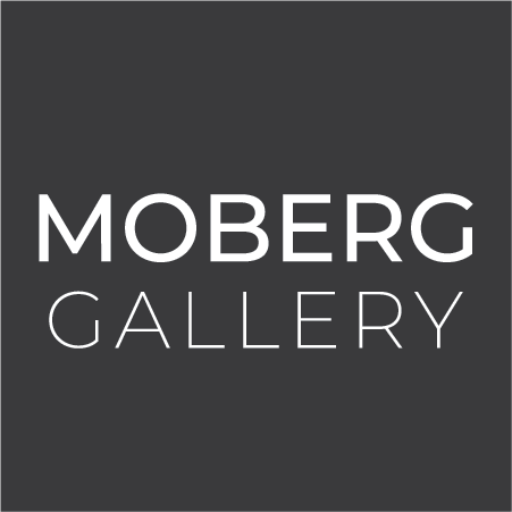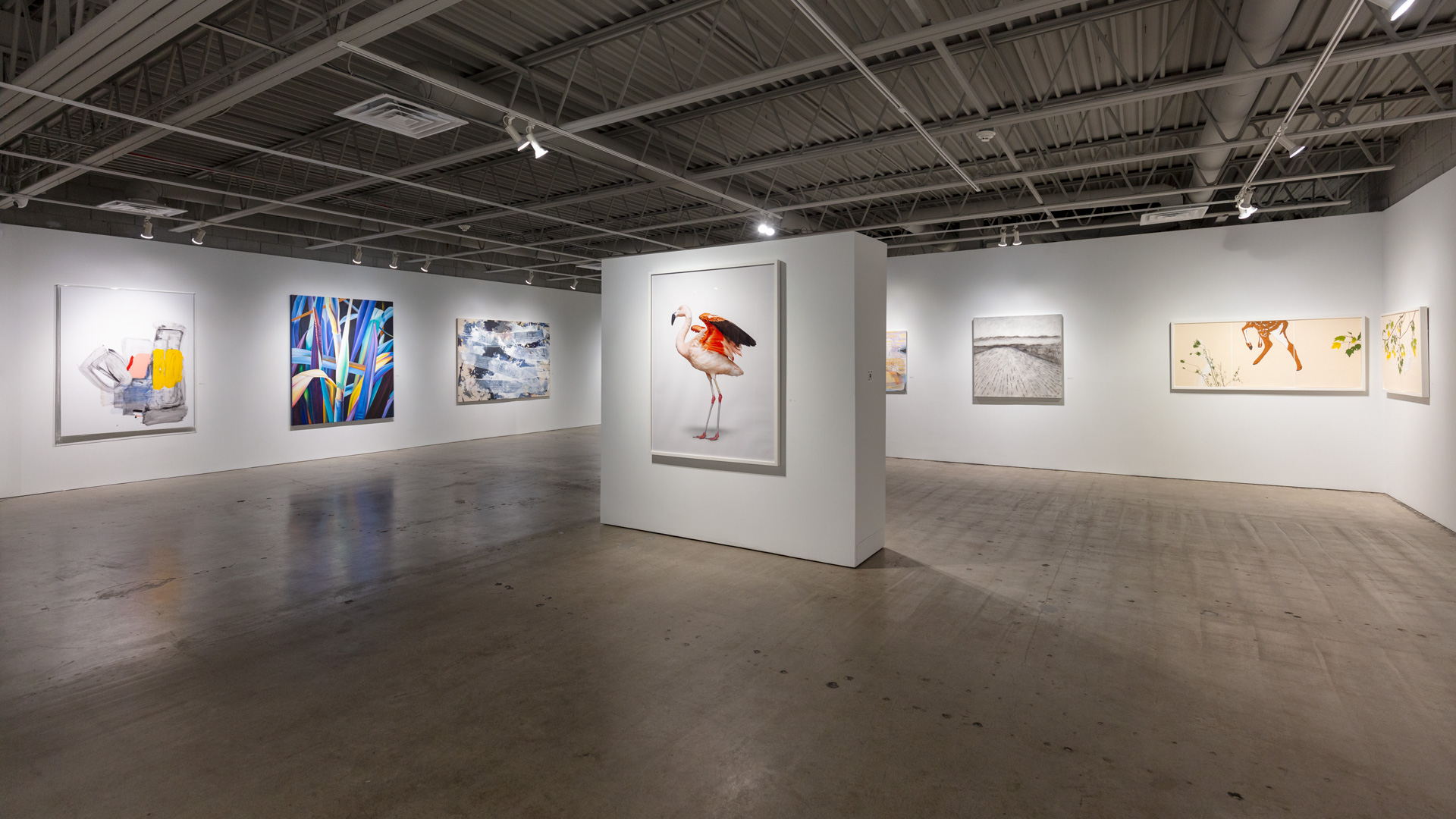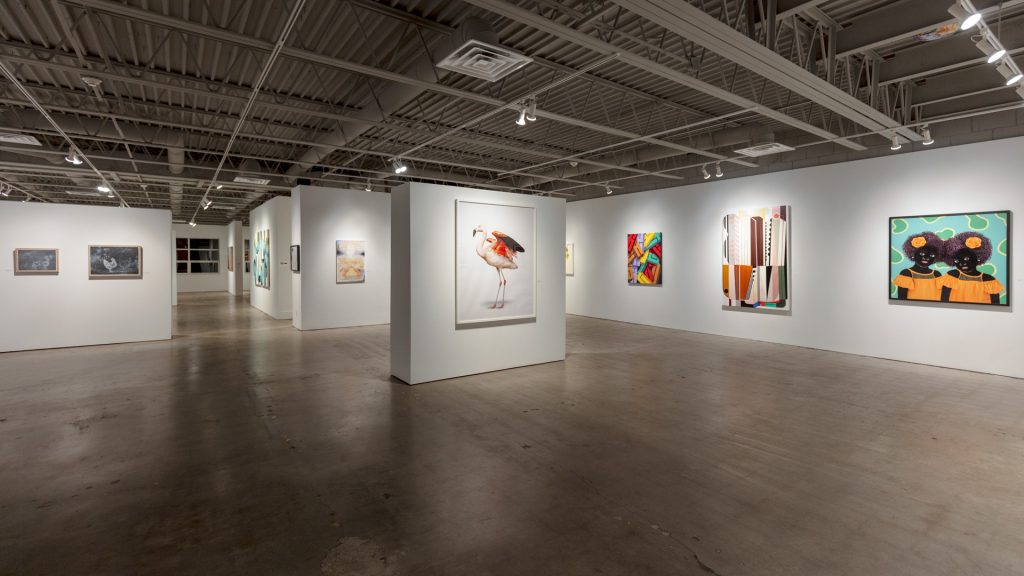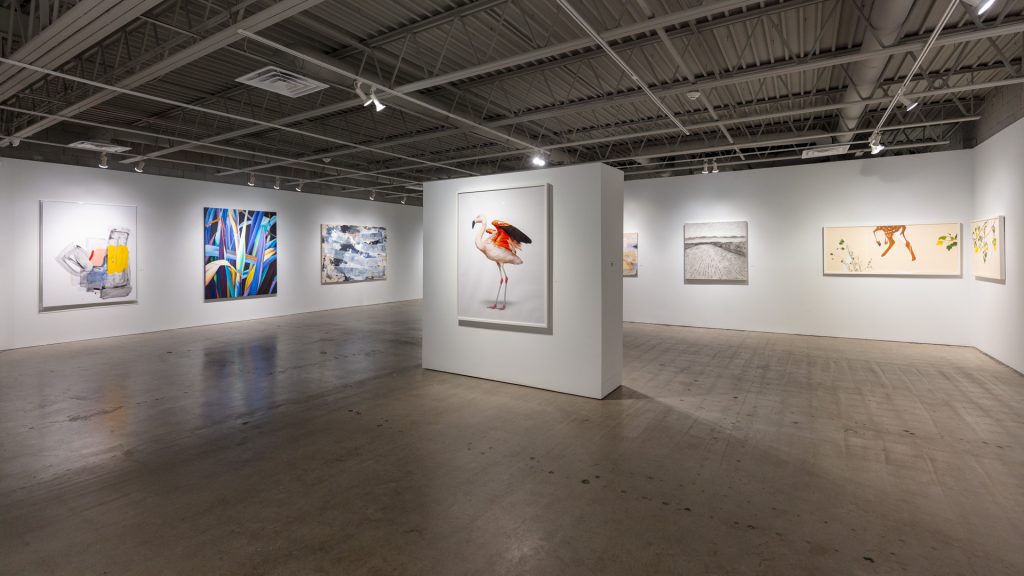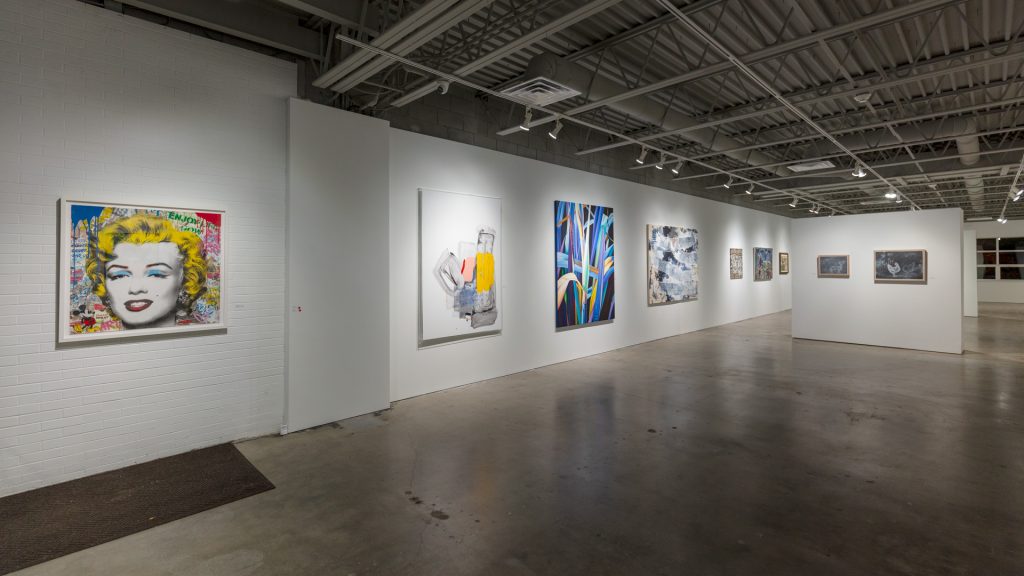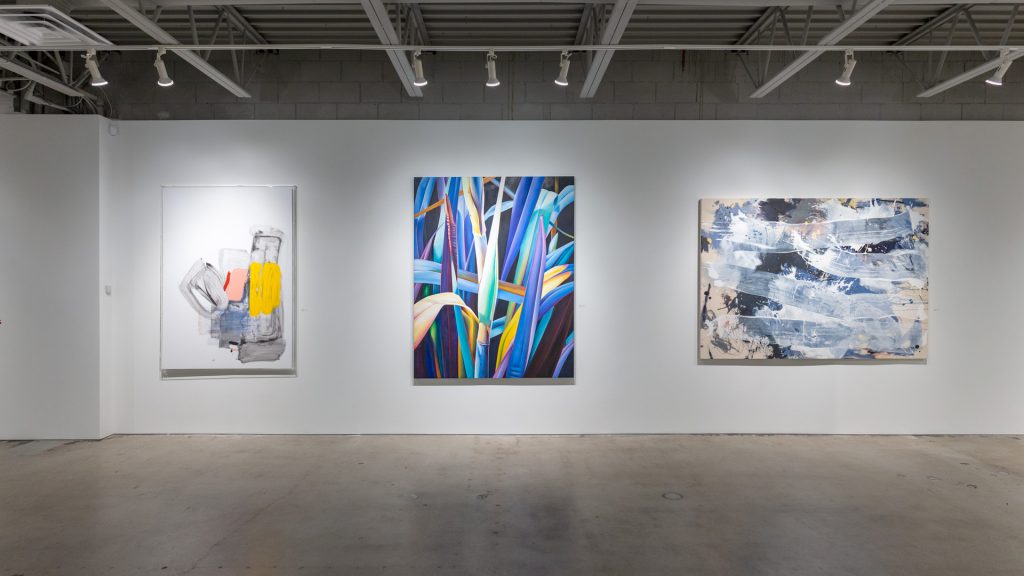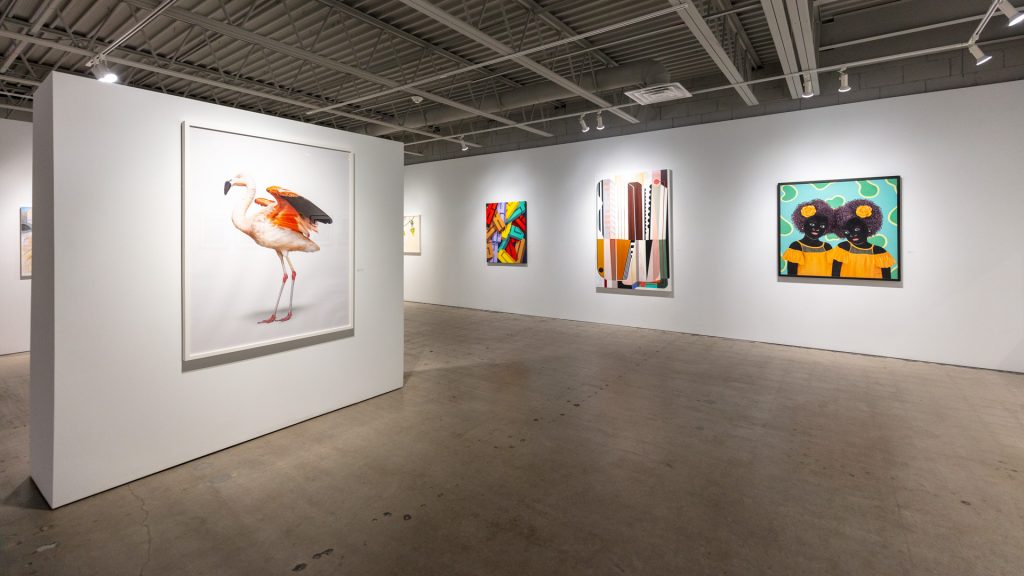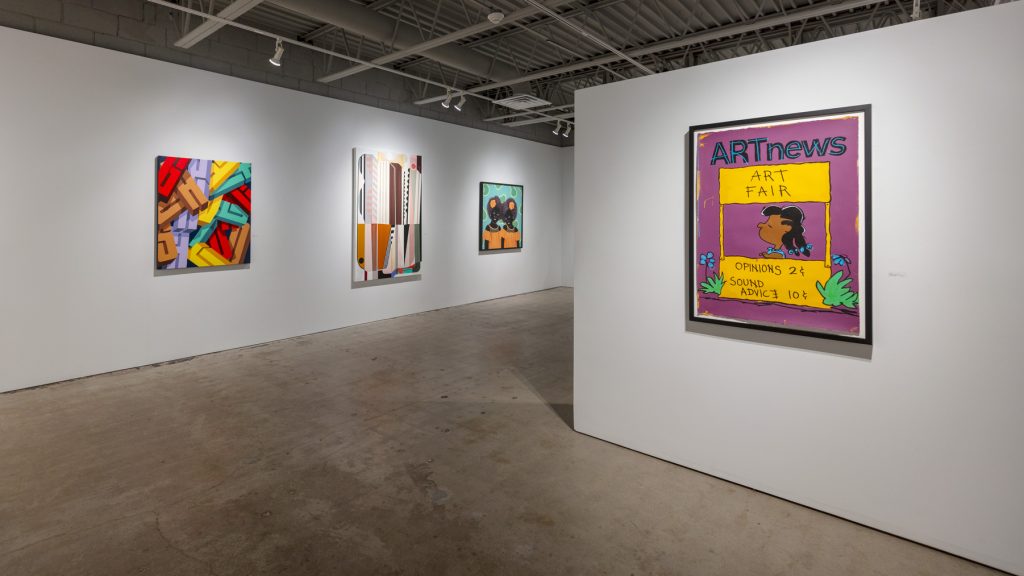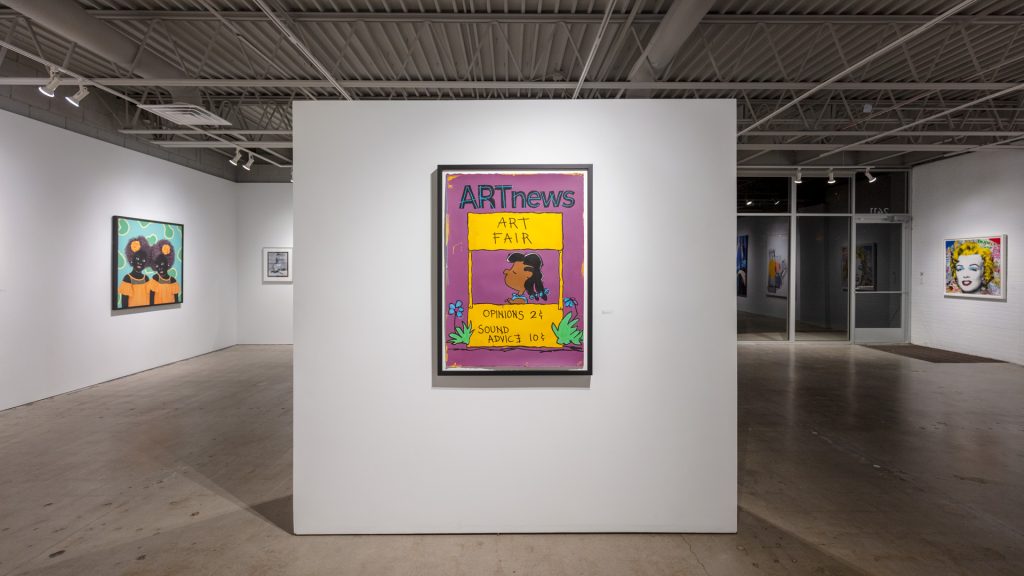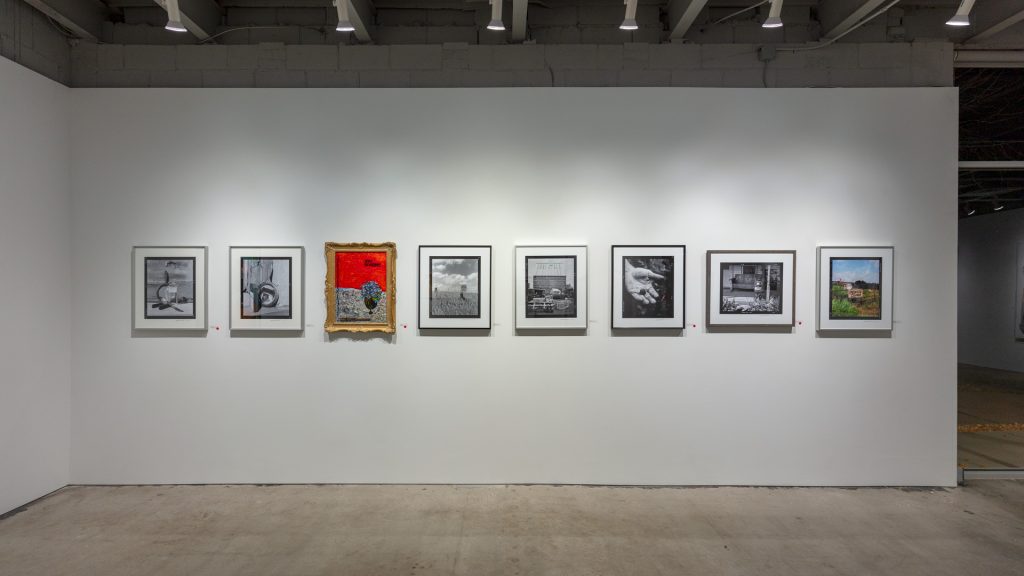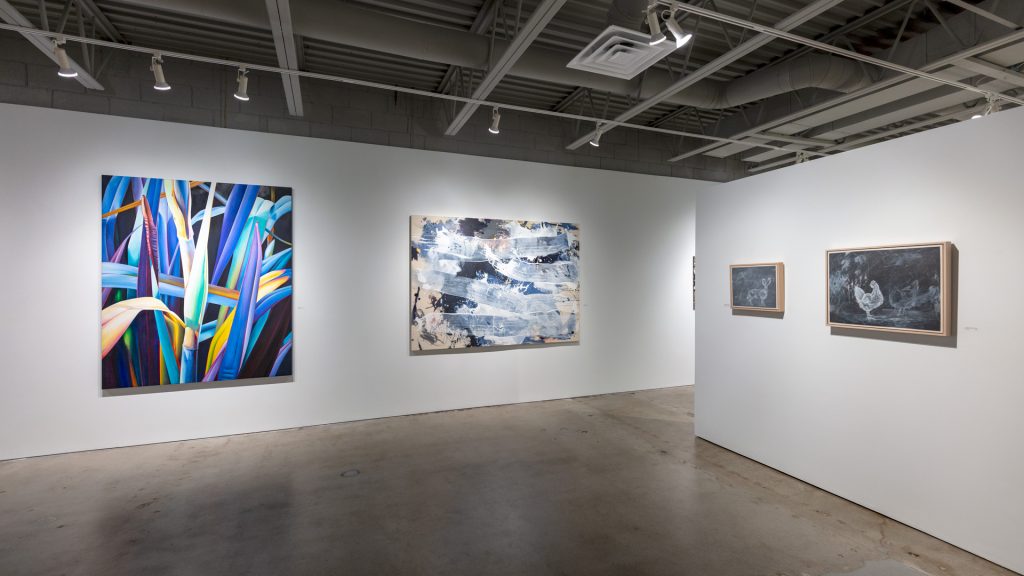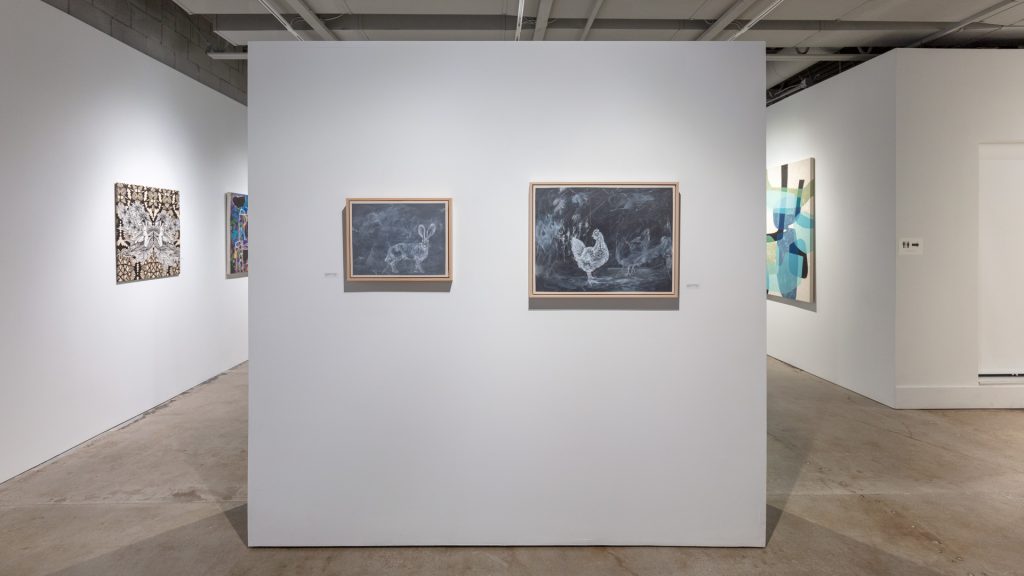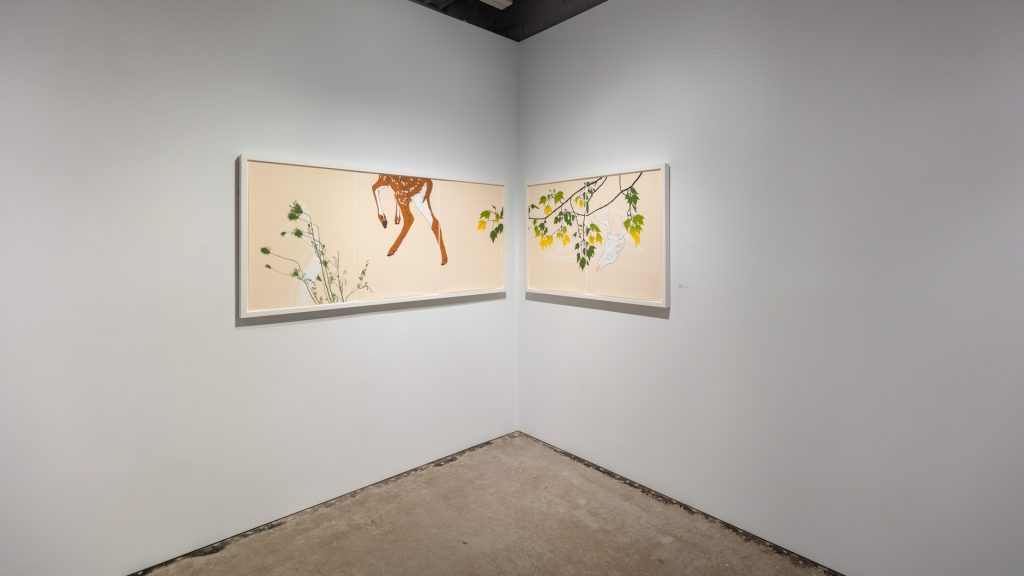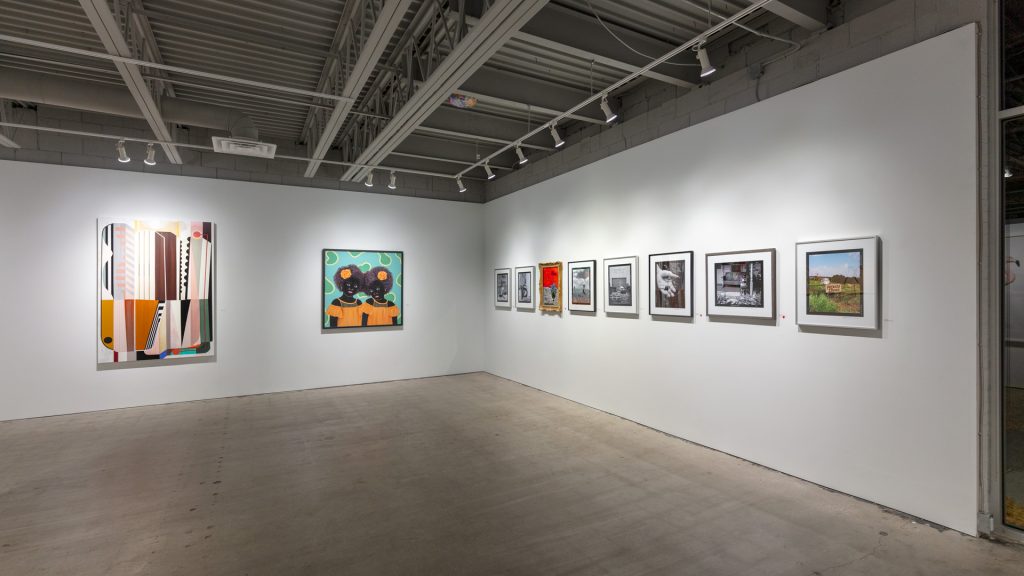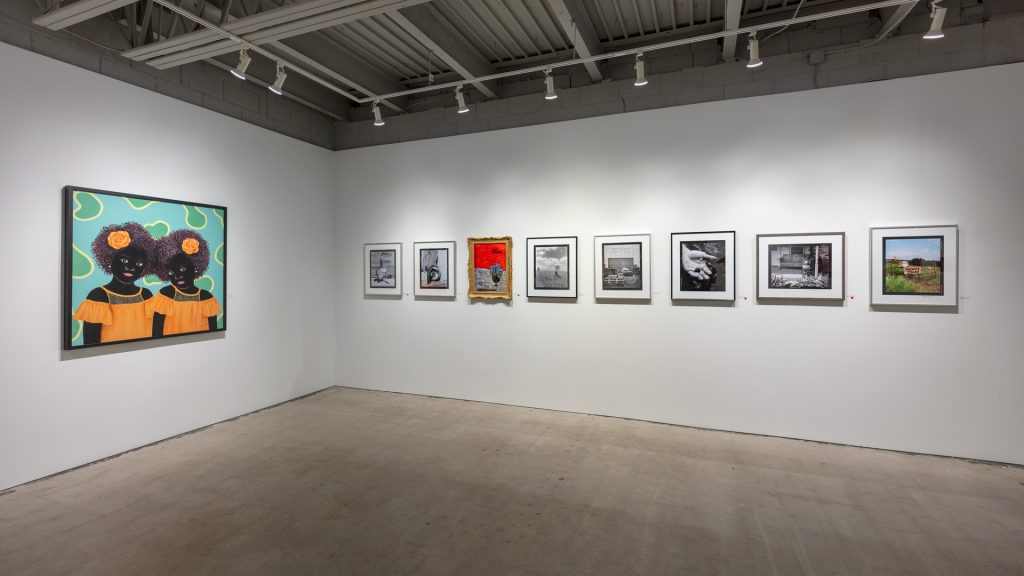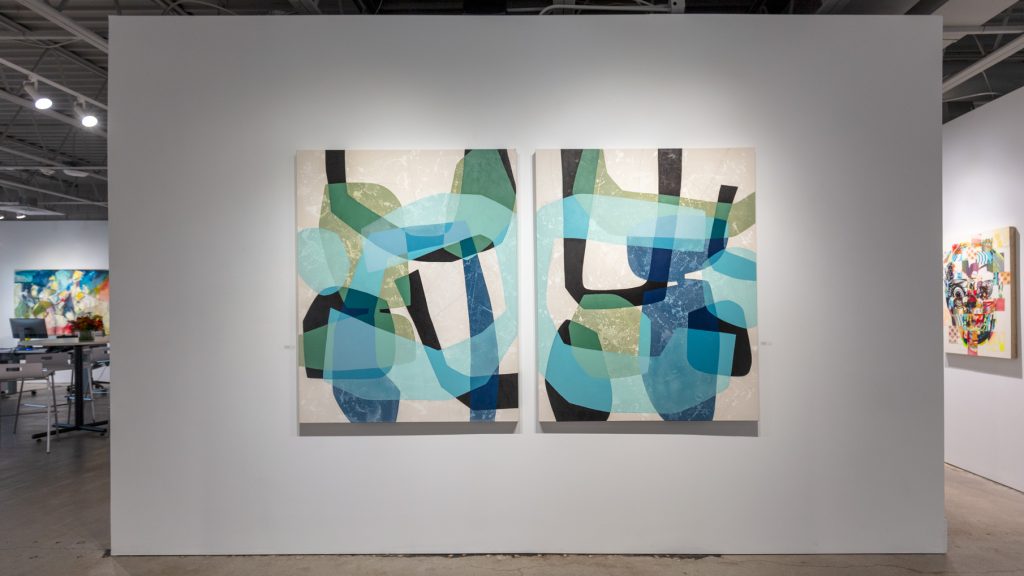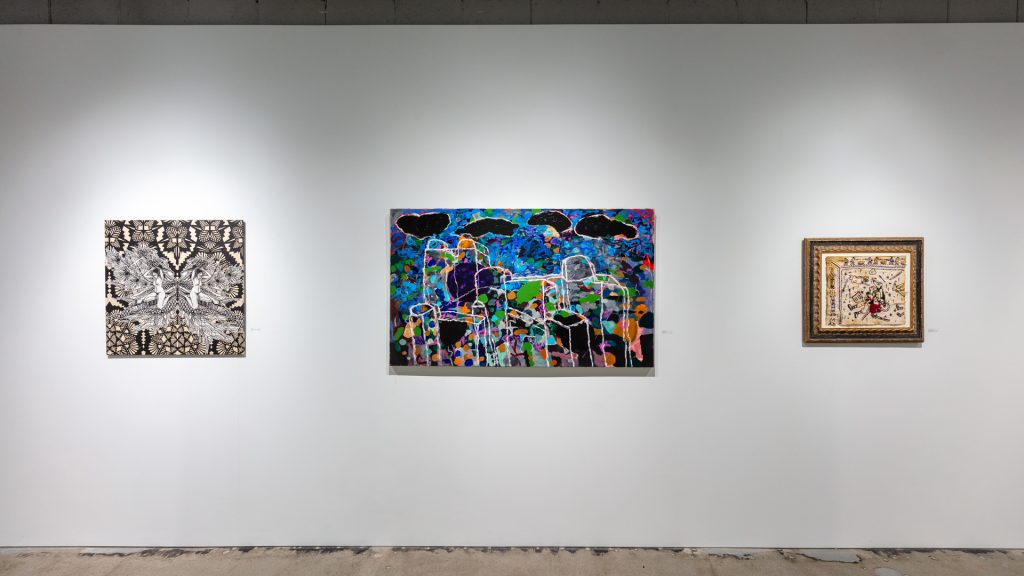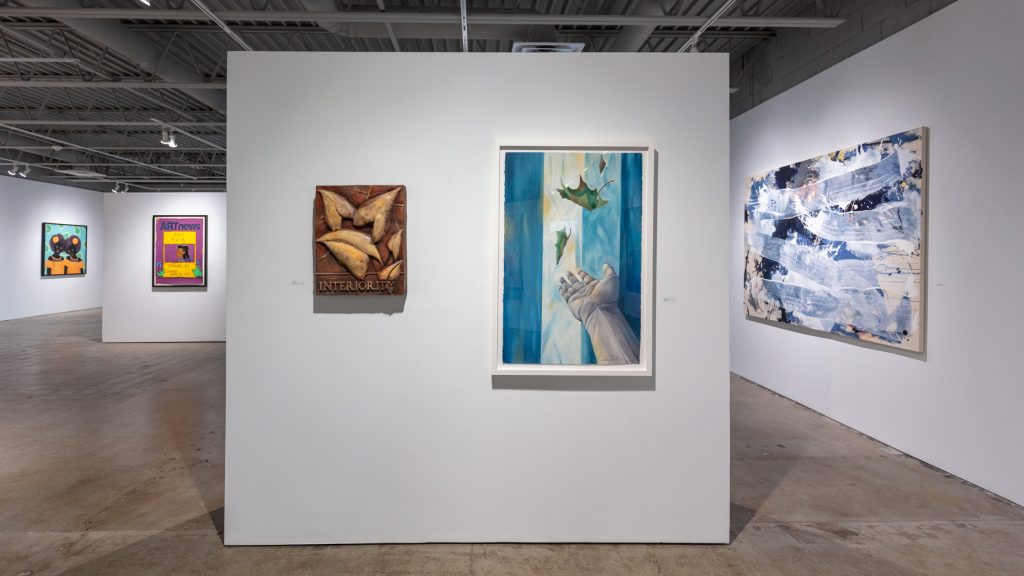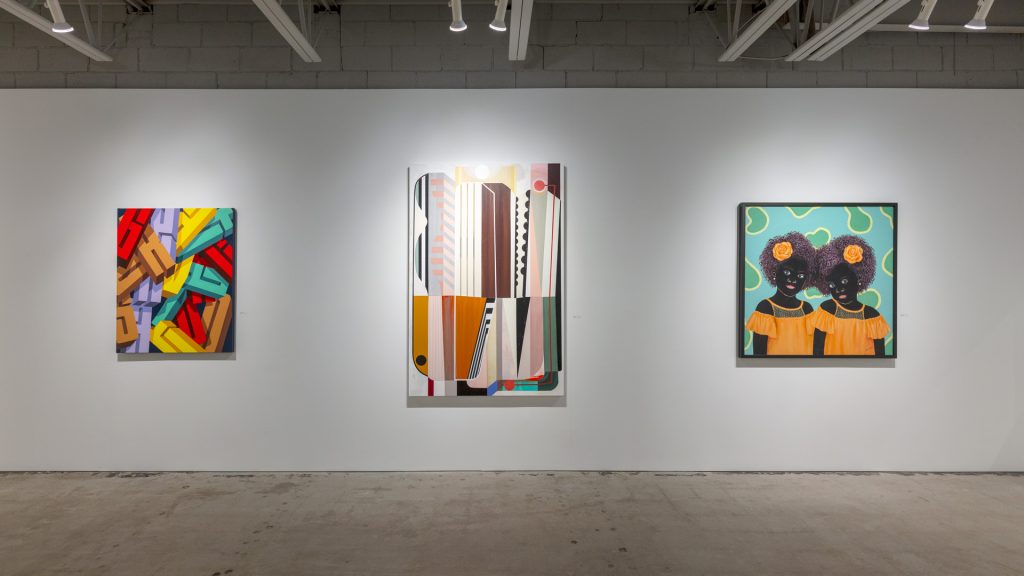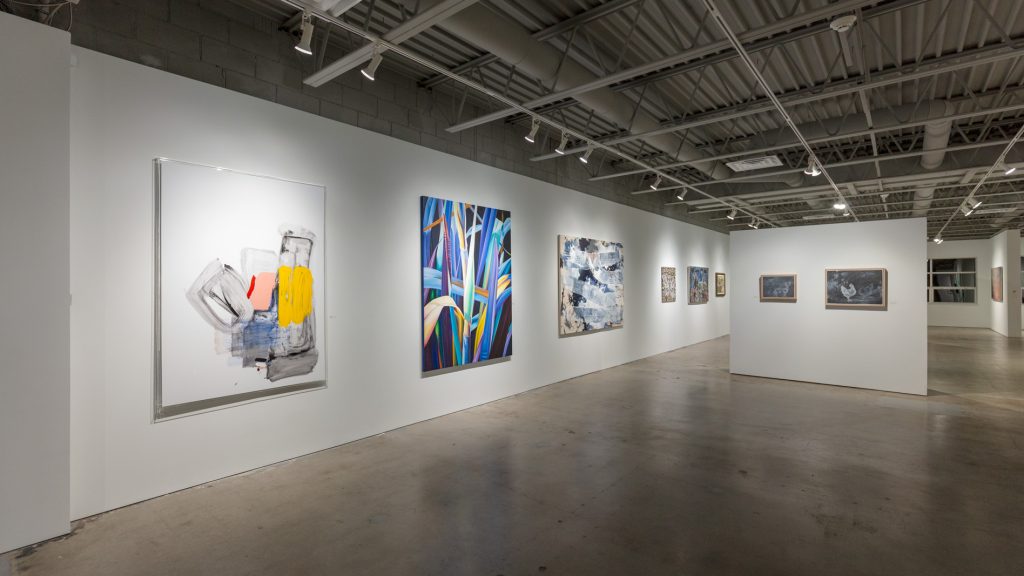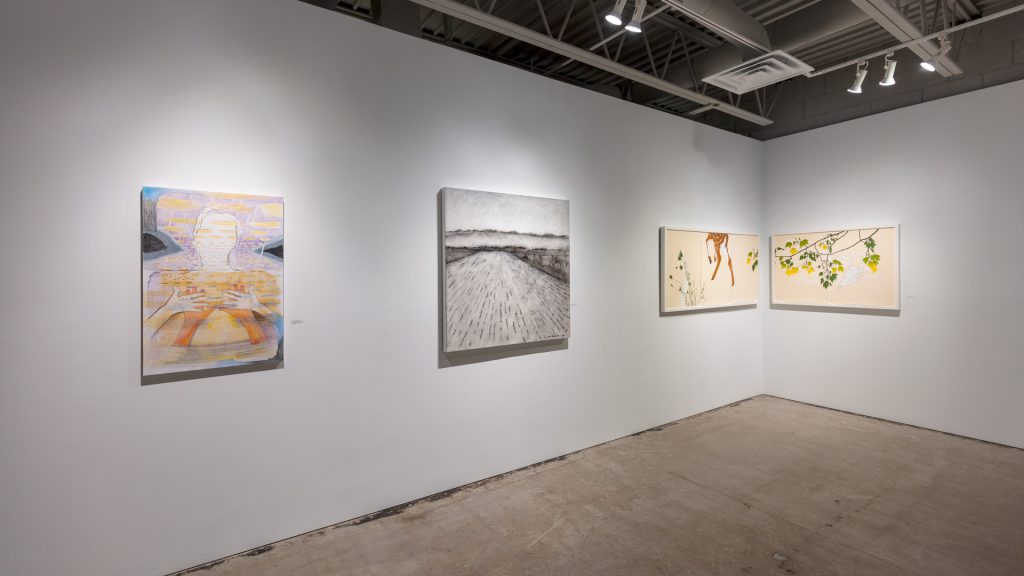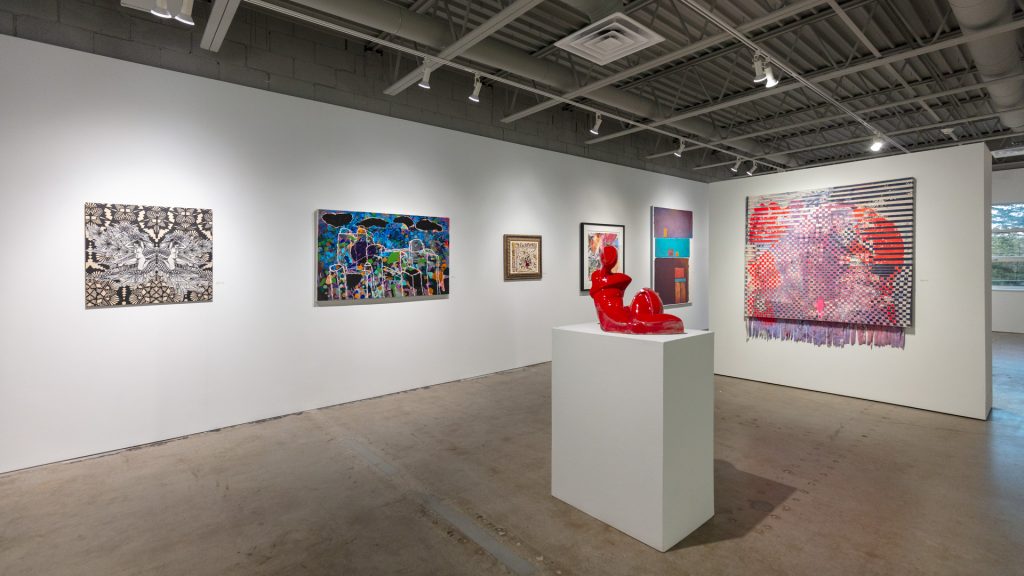TEXT BY MICHAELA MULLIN | VIEW IMAGES
Moberg Gallery is grateful and excited about celebrating 20 years in the business of championing artists and bringing beautiful artwork to clients for office, home, public and private spaces. And we love that clients and artists want to help us toast to such a monumental milestone. Over thirty artists have work on exhibit in our 20th Anniversary show. It will be up until January 6th, and we will gather for a closing reception on Friday, Jan. 5th, 5 – 8 pm, as well, with music and more. Stop in to view these amazing new works by so many wonderful makers, from Des Moines to Barcelona, San Francisco to Lagos.
Al Harris-Fernandez works with sky and structure but inverts their substantivity—what is considered solid becomes transparent, and what is considered airy finds an intriguing opacity. In “The Crossing,” Harris-Fernandez uses large dots to make a background of hybrid form and shape, creating solidity by overlaying, layering, and contouring an absence, presenting it to the viewer through and within, taking us into and across the cruxes of the work.
Sarah Grant’s “Black Hills” painting is a mesmerizing landscape puzzle made of boulders of color, hills of linear division and traces, with washes of nature’s hues. Blues cascade inside the lines, making soft barriers between the forms that buttress each other and their topographies. Grant’s use of red is always both delicate and bold, and this work it is no different. Red marks spots of import while also working to stretch the eye out, beyond.
Linda Colletta makes us nostalgic for the ’80s … and its kingdom of denim. The colors and fringe of all joyful fashion are integrated in this large-scale work, aptly titled “Oo La La Sasson.” Like a sunset seen through heat’s refraction, the waves and weaves of Colletta’s painted, torn canvas elicits red hot memories and the forward look to and of future horizons.
Dennis Atherton is a photographer of wonderful tableau. Though he works mostly in black and white photography, there is one new digital color photo, “Private Idaho” in the show. We find a colander, stiletto heel, and a sign on the fencing of what appears ranch-like. Domesticity, nights out on the town, and this sign which references to the viewers of a certain age and cinephilic leaning, an old Gus Van Sant film. There is a haunting evocation of Matthew Shepherd’s Laramie, WY, here as well. Atherton’s use of color here makes this a less haunting image, allowing the viewer to smile at the juxtaposition of objects, as assemblage of oddities, out on the range.
Randal Ford is renowned for his patient portraits of animals, domestic and wild. His process is determined, his results are direct and calming, and poignant and fun, all rolled into each shot. “Highland Cow #1” is a ridiculously fascinating portrait in all manner of white—background, hair, and horn. The cow’s gaze falls on the viewer though the eyes cannot be clearly seen for its forward falling bangs. Its mouth is closed and its chin slightly wet/dirty. It is surely a moment of short duration, which we should be happy and lucky to witness in Ford’s photograph.
Larassa Kabel uses color to lighten subject matter in her new work, “From There to Here,” a lithograph with gold leaf. The partial body of a deer—which resembles a doe; a skull from the same species—resembling that of a buck; turning leaves; and bending prairie flowers. All of these with a white touch—a light touch. This five-panel work feels like an autumnal meditation and a tempering mediation of the memento mori viewers have appreciated from Kabel for years.
David Dahlquist has paper works and a new ceramic piece in the show. The latter is a tablet, holding the word “Interiority” at the bottom, titling the leaves in relief above it. The dual nature of our inner lives, the cyclical nature of our bodily lives—these interior/exterior complements are perfectly held in this simple, straightforward work. Dahlquist is always reaching for brevity, and he finds it. His search is earnest, and the culminating art bears the stamp of its maker’s devotion to learning about the fullness of self and nature.
Kathranne Knight’s new work, “You Are a Body Transparent,” is a drawing in acrylic, color pencil, graphite, and permanent wax pastel on board. Knight’s media and substrate are changing, giving her new works a solidity and grounding which her paper works avoided by design. Her handling of all media creates a refined balance of weight and weightiness with these figurative landscapes. Knight is happy to get “back to the body” and to investigate the tracing and contour of head and hands to visually articulate such questions as “are you fading?” or “are you coming into being?” She finds beauty in not knowing the direction.
Goizanie Esain makes cityscapes and horticulture all seem lustrous and lush. Her vibrant photographs, which are then “sliced,” make for gorgeous arrangements, or linear bouquets. “A Piece of Tropic #4,” on aluminum, is a dimensional hothouse of greens and pinks, with the veining of white and turning of yellows compositionally captured to add to the depth of the flora.
Esther Oyeyemi depicts young children and adolescents in posed and beautifully subdued interactions. The backgrounds are patterned comfort zones, or familiar settings, and the dynamic between subjects is about conjoining for the viewer; they look out at us. These acrylic paintings are stark yet intimate, foregrounding the relational twinning of subjects and the environmental importance of objects to make set and scene.
Scott Charles Ross work tends to the quiet, even when evoking the horror of the Ukraine war. “First Snow,” the oil painting on linen mounted to panel, in black and white, is quiet also, but in a way that not only moves us (emotionally), but also stills us with its visual hush. Both internal modes are necessary, and Ross is the master at the syncope that interrupts our viewing calm.
Wendy Westlake overlays organic form over organic form. By allowing the whites of her background to transfer through the emerging composition, seeping through, per se, in “Simple Influences 1 and 2” and “Worth Narrating,” it’s as if she’s collaging earth-toned shapes of different media though she’s only using one, acrylic paint. The deft handling makes the shades and translucencies build dimension and the shapes of hooks and clips are all the more powerful for their cumulative effect—not locking around each other as an embrace, but their seeming haphazardness is finely tuned as imperfect forks.
Daniela Schweinsberg continues to explode viewer expectations by zeroing in on that which is compelled to largesse and largeness. “All I Need Is a Set of Wings,” acrylic on canvas, is a charismatic flight of color and stroke. Where the black motions might be a lateral movement, the golden colors, with magenta arrays and blue contrails, buoy the masses of stroke, the splatter of thrust.
Also included in the exhibit are Andrew Abbott, Derrick Briedenthal, Chuck Hipsher, Annick Ibsen, Thomas C. Jackson, Angela Johal, Alyson Khan, Mr. Brainwash, b. Robert Moore, Adele Renault, Alexandre Shiffer, Alayne Spafford, Swoon, Aaron Wilson and Tim Dooley, Chris Vance, Dennis Wojtkiewicz, and Ruben Sanchez and Teo Nguyen, whose work you can find next month in Miami with us at SCOPE International Art Fair (Booth G09) (moberggallery.com). And don’t miss the two drawings by Jeff Fleming, whose exhibit, “Absurdities,” kick starts the upcoming new year of art (opening reception on Friday, Jan. 12).
Exhibit Images
